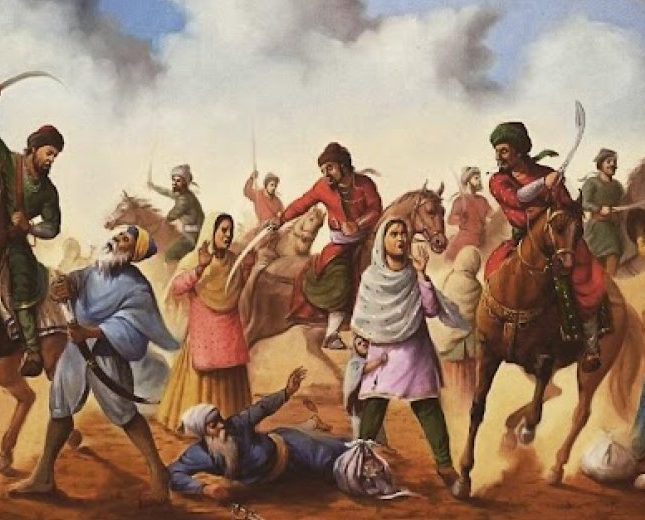VADDA GHALLUGHARA, meaning “Major Holocaust” or “Carnage,” is remembered in Sikh history as one of the darkest and most tragic episodes. This term distinguishes it from the Chhota Ghallughara (“Minor Holocaust”), which occurred in 1746. The Vadda Ghallughara refers to a one-day battle fought on 5 February 1762 between the Dal Khalsa and Ahmad Shah Durrani, resulting in a devastating loss of Sikh lives.
Following his historic victory over the Marathas in the Third Battle of Panipat (1761), Ahmad Shah Durrani was harassed by Sikh forces as he retreated from the Sutlej to the Indus. The Sikhs then returned to central Punjab, ravaging Afghan-held territories, annihilating the Afghan forces in Char Mahal, expelling the faujdar of Jalandhar, and plundering Sirhind and Malerkotla. Between June and September 1761, they captured Lahore and defeated a force of 12,000 sent from Afghanistan by Ahmad Shah, along with another led by the Afghan governor of Lahore.
At the Sarbatt Khalsa (general assembly) convened in Amritsar on Diwali, 27 October 1761, the Sikhs resolved to punish collaborators and informers of the Afghans, starting with Aqil Das of Jandiala, a Niranjania sect leader and an avowed enemy of the Sikhs. When the Sikhs besieged Jandiala, Aqil Das sent urgent messages to Ahmad Shah, who was already advancing into India at the head of a large army. As the Shah moved quickly toward Jandiala, the Sikhs lifted the siege and withdrew beyond the Sutlej, intending to send their families to safety in the Malva region before facing the invader.
Ahmad Shah, determined to punish the Sikhs, instructed Zain Khan, faujdar of Sirhind, and Bhikhan Khan, chief of Malerkotla, to block their advance. He himself covered 200 km in under 48 hours, crossing two rivers with a swift cavalry force, and caught up with the Sikhs at Kup Rahira, 12 km north of Malerkotla, on the morning of 5 February 1762. The Dal Khalsa, comprising the eleven misls and representatives of Malva Sikh chiefs, was taken by surprise.
The Sikhs repulsed initial attacks by Zain Khan and Bhikhan Khan but soon faced Ahmad Shah’s main force, which was larger and better equipped. Protecting their slow-moving vahir (baggage train) of women, children, elders, and other noncombatants, the Sikhs could not employ their usual hit-and-run tactics. Sardar Jassa Singh Ahluwalia, the Dal’s commander-in-chief, rejected Sardar Charhat Singh Sukkarchakkia’s suggestion to form a solid square of four misls for defense. Instead, he directed all misls to combine into a single force, forming a cordon around the vahir and moving toward Barnala, 40 km to the southwest, with guides from Malva acting as scouts.
As described in Prachin Panth Prakash by Ratan Singh Bhangu, “Fighting while moving and moving while fighting, they kept the vahir marching, covering it as a hen covers its chickens under its wings.” On several occasions, Ahmad Shah’s troops broke through the cordon, slaughtering the defenseless noncombatants. However, Sikh warriors repeatedly reformed their lines and pushed back the attackers. By early afternoon, both sides reached a pond, where fighting ceased as exhausted soldiers and animals rushed to drink and recover. The battle did not resume.
The Sikhs continued toward Barnala, and Ahmad Shah decided against pursuing them into the semi-desert, where his army, fatigued from two days of continuous fighting, faced further risks. Estimates of Sikh casualties vary, with figures ranging from 20,000 to 50,000. Muslim chronicler Miskin estimated losses at 25,000, while Ratan Singh Bhangu recorded 30,000 deaths. Despite this devastating blow, Sikh morale remained unshaken. That evening, according to Prachin Panth Prakash, a Nihang stood up and proclaimed, “…the weak have been shed. The true Khalsa remains intact.” Within three months, the Sikhs attacked Zain Khan of Sirhind, who paid them Rs 50,000 to secure peace, and they continued to raid the Lahore region by July–August 1762, as Ahmad Shah helplessly witnessed their resurgence.
References:
- Bhangu, Ratan Singh, Prachin Panth Prakash, Amritsar, 1914.
- Gian Singh, Giani, Panth Prakash, Delhi, 1880.
- Ganda Singh, Sardar Jassa Singh Ahluwalia, Patiala, 1969.
- Harbans Singh, The Heritage of the Sikhs, Delhi, 1983.
- Gupta, Hari Ram, History of the Sikhs, Vol. IV, Delhi, 1982.
- Gandhi, Surjit Singh, Struggle of the Sikhs for Sovereignty, Delhi, 1980.
- Bhagat Singh, Sikh Polity in the Eighteenth and Nineteenth Centuries, Delhi, 1978.






